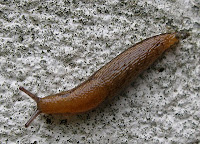Durrell's adult caretaker was alarmed, pulling Durrell away from the "filthy" things. Understandably, even though it aids their locomotion, the sliminess of slugs and snails can be a turnoff to us. But if we are self-reflective, I think we might conclude that such a repugnance comes from a natural concern about mucous discharged from our own bodies. We should not blame the little animals for that.
 Although both slugs and snail are in the same class of gastropods (having a single foot-pad beneath them for locomotion), snails have an edge on engaging practically-minded adults. Snails, besides being candidates as food (which we delicately call "escargot"), have aesthetically pleasing spiral shells, sometimes used for jewelry.
Although both slugs and snail are in the same class of gastropods (having a single foot-pad beneath them for locomotion), snails have an edge on engaging practically-minded adults. Snails, besides being candidates as food (which we delicately call "escargot"), have aesthetically pleasing spiral shells, sometimes used for jewelry..jpg) |
| sea slugs ("nudibranches") |
Although in our everyday life we usually encounter a lone garden snail or garden slug here or there, some species can live in great concentrations in their usually hidden world. I remember a biology teacher on a field trip probing into the continually damp ground on a river embankment. He wanted to show us what he thought might be the greatest concentration of snail's possible -- tiny ones, less than 1/4-inch in diameter, crowded "shoulder to shoulder," if it could be said that snails have shoulders.
Am I the only child who, when first seeing a slug, thought that it must be a snail that had somehow lost its shell? Am I the only child who felt a concern for the slug, which looked terribly vulnerable without a protective "house" on its back into which it could retreat for safety? I cannot believe I am the only child who had such thoughts.
Placing that childhood recollection of mine beside Durrell's childhood recollection, I see similarities in the caring about something and in the finding something to be wondrous. My caring, and Durrell's wonder. Both having an element of child-fullness. Maybe wonder, like caring, comes more from the heart than from the head.
~~~
Do you have any childhood or adult recollections of slugs or snails? What are they?
(The Durrell quote is from The Amateur Naturalist by Gerald Durrell, © 1982. p. 9.)
(Photo of blue nudibranches is by Alexander R. Jenner; that of the brown slug by Guttorm Flatabø [user:dittaeva].
Both are used under Creative Commons Attribution-Share Alike licenses.)

2 comments:
I enjoyed this essay. It reminded me of the love-hate relationship kids can have with things that are a bit disgusting but still interesting. I wonder if it was kid who invented the word "yucky". Thanks for the neat, fascinating pictures too.
I was fascinated when, as an adult, I learned that some sea slugs eat algae, then commandeer their chloroplasts, as well as some the algal genes. The sea slugs then use the chloroplasts to help feed themselves in lean times. Sneaky, thieving sea-slugs!
Post a Comment